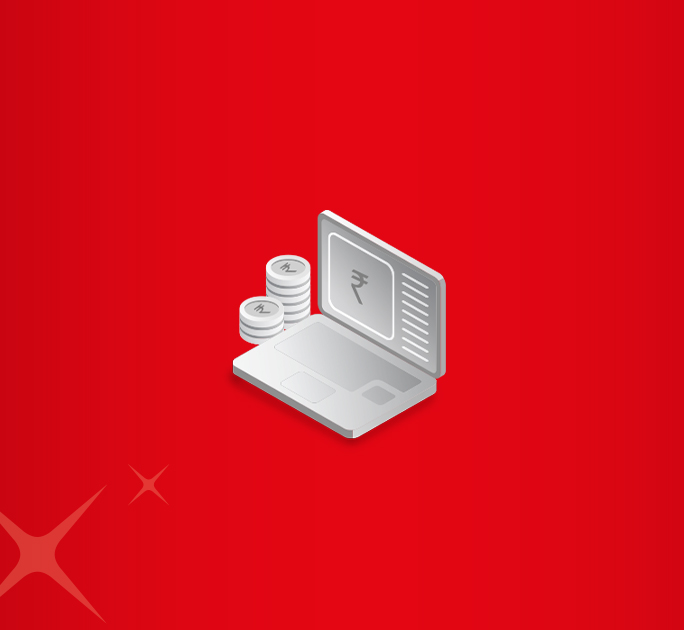- Save
- Invest
- Borrow
- Pay
- More
- Customer Services

The Role of Tax Saver Fixed Deposits in Tax Reduction
Forget the age-old advice of "a penny saved is a penny earned." When it comes to smart financial planning, there’s a more relevant saying: "A tax saved is a rupee earned." This phrase perfectly captures the value of Tax Saver Fixed Deposits (FDs), a financial tool to reduce your tax burden while growing your wealth simultaneously.
But how exactly do Tax Saver FDs work, and are they the right fit for you? Let's explore Tax Saver FDs, exploring their features and benefits, and comparing them with other investment options. But first, let’s start with understanding what is a Tax Saver Fixed Deposit.
What is a Tax Saver Fixed Deposit?
A Tax Saver Fixed Deposit is a special bank deposit that allows investors to benefit from tax deductions under Section 80C of the Income Tax Act, 1961. By investing in this FD, individuals can claim a deduction of up to ₹1.5 lakh annually from their taxable income. Simply put, investing in a Tax Saver FD can lower your tax burden and save you more money. It's a secure investment with assured returns, ideal for those seeking tax savings along with stable investment returns.
Read More: - What is Fixed Deposit?
How Tax Saver Fixed Deposit Works?
Now that you know what a Tax Saver Fixed Deposit is, let’s understand how this type of deposit works.
As mentioned above, the amount deposited in a Tax Saver Fixed Deposit qualifies for tax deduction under Section 80C of the Income Tax Act. This allows you to reduce your taxable income by the amount invested, up to a specified limit. The deposit comes with a lock-in period, which means early withdrawal is not permitted. While the interest earned on this deposit is taxable, the principal amount along with the accumulated interest is credited to your linked savings account upon maturity.
For example, if you invest ₹1 lakh in a Tax Saver FD, you can deduct ₹1 lakh from your taxable income for that year, subject to the overall Section 80C limit.
Features of Tax Saver Fixed Deposits
Here are the key features of Tax Saver Fixed Deposits:
- You can claim a tax deduction on your investment amount of up to ₹1.5 lakh under Section 80C of the Income Tax Act.
- These FDs have a mandatory lock-in period of 5 years, meaning you cannot withdraw your money before maturity.
- You can deposit a minimum of ₹100 and a maximum of ₹1,50,000 in a Tax Saver FD per financial year.
- Interest payouts on your FD can be monthly, quarterly, half-yearly, or yearly. Alternatively, you can choose a cumulative FD where interest is compounded and paid out with the principal amount at maturity.
- Tax Saver FDs can be opened individually or jointly. However, only the first holder can claim the tax deduction under Section 80C in the case of a joint account.
- You cannot make premature or partial withdrawals before the 5-year lock-in period ends, ensuring the investment stays intact for the tax benefits.
- Like other deposit accounts, you can nominate a beneficiary for your Tax Saver FD who will receive the maturity amount if you pass away.
Benefits of Tax Saver Fixed Deposits
Attractive Interest Rates
Tax Saver Fixed Deposits offer attractive interest rates, typically ranging from 6.50% to 7.00%, which are often higher than other investment options.
Tax Benefits
The primary benefit of Tax Saver FDs is the tax benefit. The principal amount invested qualifies for a deduction under Section 80C of the Income Tax Act of 1961. You can claim a maximum deduction of ₹1,50,000 in a financial year.
Additional Interest for Senior Citizens:
Senior citizens benefit from a higher interest rate on these deposits, with banks offering an additional 0.5% above the standard rates for deposits.
Easy to Open:
Opening a Tax Saver FD is simple and can be done online or by visiting a bank or post office. You can make a one-time lump sum deposit and invest anywhere from ₹100 to ₹1.5 lakhs per year.
Additionally, the documentation required to open a Tax Saver FD is minimal. You only need to provide copies of identity and address proof, such as a PAN card, Aadhaar card, Voter ID card, Driving license, Passport, Utility bills, etc.
Accounts for Minors:
Tax Saver FDs can also be opened for minors, provided they are joint accounts with adults. This is a great way to start financial planning for children.
Secure Investment:
Tax Saver Fixed Deposits are a secure investment since the principal amount is protected. Upon maturity, you receive both the initial investment and the accrued interest.
Understanding FD Tax Exemption Limits for Interest Income
Now that we've discussed the basics of Tax Saver FDs, let's explore the Tax Deducted at Source (TDS) exemption limits on Fixed Deposits.
Understanding the FD interest tax exemption limit is essential while planning for your financial future. These limits are set by Income Tax rules and typically differ based on your age and taxable income.
For most individuals, the exemption on TDS for FDs is ₹40,000 per financial year. This means if the interest you earn on your FDs is below this amount, no tax will be deducted at source. Senior citizens, however, get a higher exemption of ₹50,000, recognising their financial needs.
An even more significant exemption applies to individuals with a total taxable income below ₹2.5 lakh. In such cases, no TDS will be deducted from any FD interest earned. To claim this exemption and avoid upfront tax deductions, individuals simply need to submit Form 15H (for senior citizens) or Form 15G (for others). This ensures that low-income earners are not spared unnecessary tax deductions.
Remember, the FD tax exemption limits can change over time. So, make sure to stay informed through government sources or your bank. This will ensure you make informed decisions and comply with the latest TDS regulations on FDs in India.
Also Read: - How Can Fixed Deposits Improve Your Financial Portfolio?
Comparing Tax Saver FDs With ELSS
Fixed Deposits offer security and guaranteed returns, but they aren't the only option for saving on taxes and accumulating corpus.
Another viable option to consider is Equity Linked Saving Schemes (ELSS) mutual funds. While FDs are considered among the safest options for saving, offering both capital protection and growth unaffected by market fluctuations, the returns from FDs are subject to taxation.
This is where ELSS can help you. When you invest in ELSS mutual funds, you typically get higher returns that are tax-free. Plus, with a short lock-in period of just 3 years, it allows for greater flexibility compared to Tax Saver FD and other tax-saving investment avenues.
|
Feature |
Tax Saver FD |
ELSS |
|
Returns |
6.5% to 7% |
6% to 18% |
|
Lock-in Period |
5 years |
3 years |
|
Tax on Returns |
Returns are taxable |
Returns are tax-free |
|
Risks |
Low |
Moderate to High |
|
Growth Potential |
Limited |
Higher (market-linked) |
|
Flexibility |
Low (fixed lock-in period) |
Higher (can redeem after lock-in) |
|
Liquidity |
Low (cannot withdraw before maturity) |
More liquidity after the lock-in period |
Who Should Invest in a Tax Saver FD vs. Who Should Invest in ELSS
You’ve likely heard about considering your age, risk tolerance, and investment timeframe before investing in any financial instrument. The same principles apply when determining whether a Tax Saver Fixed Deposit or ELSS is suitable for you.
a. You should invest in a Tax Saver FD if:
- You're approaching retirement and prefer low-risk options. It offers assured returns with minimal risk. Just make sure to compare the interest rates offered by different Tax Saver FDs to find one that aligns with your investment goals.
- You want to reduce your tax burden. Tax Saver FDs enable you to claim deductions under Section 80C, thus lowering your taxable income.
- You have a goal in mind that's five years away, such as a down payment on a house or buying a vehicle. A Tax Saver FD can help you accumulate funds with guaranteed returns, supporting your savings objectives.
b. You should invest in ELSS if:
- Individuals or Hindu Undivided Families (HUFs) looking to save up to ₹46,800 annually on taxes can consider investing in Equity Linked Saving Schemes (ELSS).
- These funds are ideal for those willing to take some risk and who can remain invested for at least the mandatory lock-in period of three years.
- Young investors at the beginning of their careers can benefit from investing with a long-term perspective. Moreover, they can leverage the power of compounding over time and enjoy high returns while saving on taxes up to ₹46,800 annually.
Take Away
Tax Saver Fixed Deposits are a valuable financial tool for reducing your tax burden and saving for your future. They offer assured returns, tax benefits, and security, making them suitable for risk-averse investors seeking tax savings alongside steady growth. However, consider your investment goals and timeframe and risk tolerance before investing. If you have a longer investment horizon and are comfortable with moderate risk, explore ELSS for potentially higher tax-free returns.
Frequently Asked Questions (FAQs)
-
What is the lowest amount for FD?
The minimum deposit amount for a Fixed Deposit typically starts at ₹100.
-
Are Tax Saving FDs risky?
Tax Saving Fixed Deposits offer complete security. Your invested amount is fully protected, ensuring risk-free investment, with guaranteed returns.
-
What is the tenure of a Tax Saving FD?
The tenure of a Tax Saving Fixed Deposit is typically 5 years.
-
What is the FD tax exemption limit?
The FD tax exemption limit under Section 80C of the Income Tax Act is up to ₹1.5 lakh per financial year.
*Disclaimer: This article is for information purposes only. We recommend you get in touch with your income tax advisor or CA for expert advice.










